Closed-End Funds vs. Open-End Funds

- Closed-End Funds vs. Open-End Funds – Which Is the Better Choice?
- What Is a Closed-End Private Fund?
- What Is an Open-End Private Fund?
- Conclusion: Which Fund Is Better?
- What About REALTY BUNDLES’ Investment Strategy?
Closed-End Funds vs. Open-End Funds – Which Is the Better Choice?
In the evolving world of investment, investors often encounter two main options: investing in closed-end private funds or open-end private funds. Each of these funds has unique characteristics that affect investment liquidity, risk level and potential returns. This article explores the differences between these two types of funds, examines the advantages and disadvantages of each, and provides insights to help you make an informed decision tailored to your financial needs. Whether you are an experienced investor or new to the field, understanding these differences is key to achieving your financial goals.
What Is a Closed-End Private Fund?
A closed-end private fund raises capital from a limited number of investors at the time of its establishment and does not allow new investors to join or existing investors to withdraw their investments until the conclusion of a predefined term.
Advantages
- Invest in Less Liquid Assets: These funds can invest in less liquid assets, such as private real estate, private debt or private equity, enabling them to leverage high-return investment opportunities.
- Active Management: Fund managers can focus on long-term active management without being constrained by investors’ liquidity demands.
- Asset Stability: Since withdrawals are not allowed during the investment period, the fund’s assets remain stable and are not subject to fluctuations caused by deposits and withdrawals.
Disadvantages
- Low Liquidity: Investors cannot withdraw their funds until the predefined term ends, which can be a drawback should an investor urgently require their capital.
- Higher Risk Exposure: Investing in less liquid assets can be riskier and lead to greater uncertainty compared with liquid assets.
- Higher Management Fees: Closed-end funds often charge higher management fees due to the active management required and the associated higher risk.
What Is an Open-End Private Fund?
An open-end private fund allows investors to join or exit the fund periodically, typically on a monthly or quarterly basis. These funds raise capital continuously and allow investors to withdraw their investments according to the fund’s terms.
Advantages
- Relatively Liquid: Investors can join the fund and withdraw their investments during predefined periods (e.g. quarterly), providing greater flexibility.
- NAV-Based Pricing: The investment price is determined by the net asset value (NAV) of the fund, reflecting the true value of its assets.
- Risk Diversification: Open-end funds often invest in a wide range of assets, facilitating effective risk diversification.
Disadvantages
- Limited Liquidity: Although relatively liquid, investors cannot withdraw their investments at any time but only during predefined periods.
- Higher Management Fees: Open-end funds may charge higher fees due to the costs associated with active asset management.
- Investment Restrictions: The fund may need to maintain a certain level of liquidity, potentially limiting its ability to invest in less liquid but high-return assets.
Conclusion: Which Fund Is Better?
Open-end real estate funds offer a flexible and convenient solution for investors compared with closed-end funds where money is “locked in” for long periods. Open-end funds allow investors to join or withdraw from the funds at fixed intervals, such as monthly or quarterly, giving investors greater control over their investments.
Another significant advantage of open-end funds is transparency. In an open-end fund, the value of the investment is based on the actual value of the assets (NAV), providing investors with clear insight into the fund’s status.
Additionally, open-end funds allow broad diversification across various assets, reducing overall risk. Even if a specific market faces challenges, the investment remains stable thanks to the distribution of funds across diverse projects.
Ultimately, each investor must decide which fund is right for them based on their financial goals, desired liquidity, stability preferences and management style.
What About REALTY BUNDLES’ Investment Strategy?
REALTY BUNDLES provides a comprehensive solution to managing open-end real estate funds, including asset selection and ongoing management. Through our “Bundles” model, we offer investors simple and accessible entry into the real estate market. This approach is ideal for those who are hesitant about making a long-term financial commitment or concerned about the complex management issues that real estate investments can involve.
With operations in the US, the UK, France, Germany, Spain, Canada and more, hundreds of investors have already made the choice to join REALTY BUNDLES.
